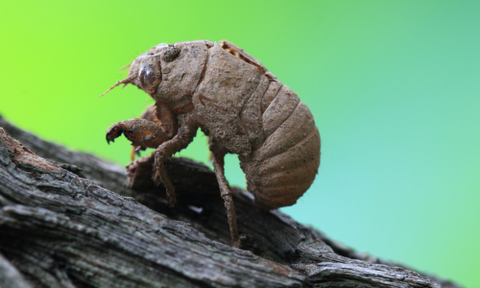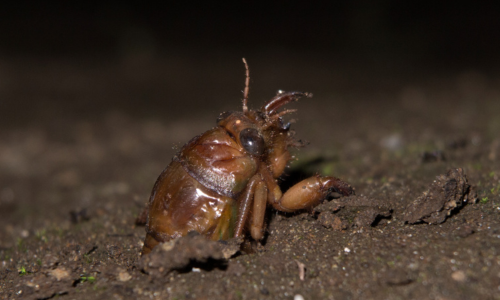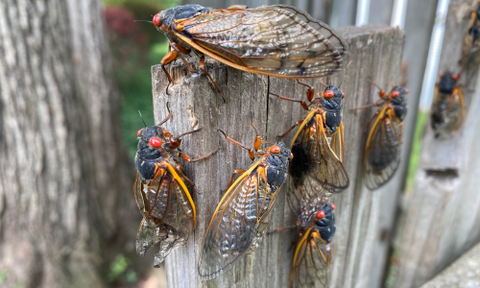Updated on September 30, 2025
- Cicada larvae (nymphs) live underground 2—17 years, feeding on root xylem.
- They usually stay within the top ~2 feet of soil (rarely deeper).
- Mass emergence often starts when soil at ~8 inches reaches ~64°F (18°C).
- They don't bite or sting and rarely harm healthy trees.
- Their tunnels aerate soil and post-emergence carcasses add nitrogen.
Cicada larvae—technically nymphs—spend years underground before a brief, noisy finale above ground.
Quick facts
- Underground stage: 2–17 years
- Typical depth: 0–24 in (rarely deeper)
- Emergence trigger: ~64°F (18°C) at ~8 in depth
- Diet: Xylem sap from roots
- Risk to people/pets: None; they don't bite or sting
- Landscape impact: Aeration tunnels; nitrogen pulse from carcasses
What are cicada larvae (nymphs)?
The underground stage of a cicada is technically a nymph—often called a “larva”—that feeds on root xylem for years before emerging to molt into a winged adult. After hatching from eggs laid in tree bark, tiny nymphs drop to the soil, burrow down and attach to fine roots. They’re wingless, compact and equipped with strong digging forelegs to move through soil. They live a secretive existence underground, growing slowly and molting several times, until they tunnel up and shed their nymphal skin at the surface.

Lifecycle note: Adult female cicadas lay clusters of eggs in tree twigs—often totaling hundreds (up to ~600)—which hatch and drop to the soil to begin the nymph stage.
How long do cicada larvae live underground?
Most cicada larvae remain underground for 2–17 years, depending on species. Periodical cicadas synchronize in 13- or 17-year broods, creating dramatic, rare mass emergences, while so-called “annual” species still spend multiple years below ground before adults appear each summer.
Cicada larvae in the ground: how deep and when do they emerge?
Cicada larvae typically live in the top 0–24 inches of soil, and mass emergence often begins when soil at about 8 inches reaches ~64°F (18°C). Depth varies with soil type and where fine roots are most abundant; most activity stays shallow, though rare reports go deeper. Warm, moist spring conditions speed their final tunneling to the surface.
Are “cicada grubs” the same thing as cicada larvae?
People often say “grub,” but cicadas aren’t beetles—“grub” usually means beetle larvae; cicada “grubs” are actually cicada nymphs. They can look similar (chunky bodies with strong digging forelegs), but they belong to different insect groups and have different lifecycles and biology.
The life beneath: Cicada larvae's 4 key underground roles
-
Cicada larvae engineer the earth: Cicada larvae create natural soil vents. Their tunneling activities carve out numerous passageways, which, thanks to a unique 'glue-like' substance they secrete, remain open throughout the growing season. This transformative process markedly aerates the soil, enhancing its structure and significantly improving water infiltration and root penetration. This 'glue' acts as a natural stabilizer for these subterranean channels, preventing collapse and ensuring a steady flow of air and nutrients.

- Cicada larvae irrigate the land: The emergence holes the cicadas leave behind act as conduits for rainwater, significantly enhancing soil moisture levels by allowing water to penetrate deeply beyond the surface layer. This influx of moisture promotes robust plant growth and stimulates microbial activity — essential components for sustaining a vibrant and healthy soil ecosystem.
- Cicada carcasses enrich the soil: Cicada larvae contribute to soil health through decomposing adult cicada carcasses, which significantly enriches the soil with nitrogen. This vital process turns cicada remains into a potent fertilizer, enhancing soil fertility and promoting a thriving ecosystem of plants and soil microbes.
- Cicada larvae influence atmospheric conditions: Cicada larvae's tunneling encourages microbial processes that increase carbon dioxide and nitrous oxide levels but may reduce methane—a subtle yet significant impact on greenhouse gas dynamics. Through this, cicada larvae contribute to the balance of gasses that shape our climate.

Note (2024): In 2024, Broods XIII and XIX emerged in the U.S. at the same time—a rare overlap that happens about once every 221 years.





















